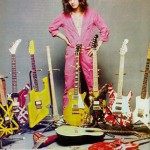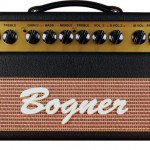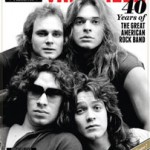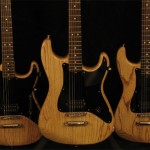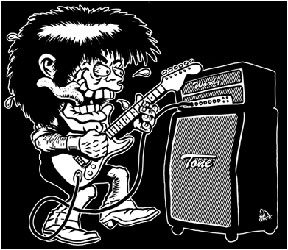Thin Lizzy: John Sykes and Scott Gorham Info
No One Touches Sykes’ Les Paul!
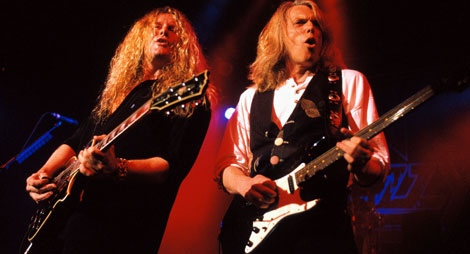
I happened upon a cool, recent interview on PremierGuitar.com of Scott Gorham. Good stuff there, but not a lot on his Thin Lizzy-era gear, maybe because it was Les Pauls and Marshalls and that’s it. But I had to find out, which led me to a Performing Musician interview with Thin Lizzy guitar tech John Gaillard that had cool info on Scott and John. So here’s a blend of the two. Both articles are worth reading in full.
Scott Gorham
Back in the day he used Les Pauls into 100-watt JMP Marshalls. Now it’s custom Strat-shaped guitars with Floyd Roses (though still somewhat like Les Pauls) into ENGL Ritchie Blackmore heads into Marshall and ENGL cabs.
PG: One guitar you’re often linked to is a Sunburst Deluxe. What’s the story behind that guitar?
Scott: On the first day I showed up for that initial meeting with the guys, Phil [Lynott] introduced me to the rest of the band and told me to pull out my guitar so he could teach me a couple of the songs. I opened up this guitar case and out came this old, black Japanese Les Paul copy with no name on the headstock. I remember looking over at Brian Robertson and Brian Downey and they both rolled their eyes and were probably thinking, Holy crap, who is this guy? It was such a piece of shit. I think at one point during that first meeting the volume knob and a screw even fell off.
After I actually got the gig with Thin Lizzy, I remember going back for the first day of rehearsals and Phil said to me, “If you’re going to be in this band, we have to buy you a decent guitar.†I was all for that so we both went down to a place called Tottenham Court Road in London–it’s where all the guitar shops were at back then–but the problem was we had a real strict budget. Unbeknownst to me, Thin Lizzy at that point was heavily in debt, so to even get a new guitar at all was pretty amazing. Of course, I went straight to the expensive guitars and I could see Phil starting to sweat. He kept trying to draw my attention away from the top-dollar guitars and so I finally grabbed this sunburst Deluxe and plugged it in. It sounded pretty good and it had a great neck on it with a perfect shape to my hand, but most importantly, the price was right. And that’s how I landed that Deluxe you see me with in so much of the old footage. I played that guitar for the first three albums.
What about the other Les Paul?
We were touring in the US and a vintage guitar dealer came down to a show in Boston and flipped open about six boxes and I made a bee-line for this one guitar. He told me it was a ’59, but it was actually a ’57. I picked it up and it felt right. It sounded like a Thin Lizzy guitar. I asked our sound guy, Pete, what he was hearing and he just looked at me and said, “Buy it.†I looked down at the dealer and said, “Well, that just blew any negotiation on my part.†After a while, the wine red finish began to wear off and it appeared to have a gold top finish originally, so who knows what that guitar was.
His guitars now:
Scott: “You start wielding those babies [Les Pauls] around for two hours and your back is misaligned, your shoulder is destroyed and your neck is strained. It’s funny now because our other guitarist, John Sykes, still carries a big lump of mahogany wrapped around his neck all night and his shoulder is just killing him. But, he’ll never trade that guitar in for anything. That’s why I went to the Strat as my main guitar. I’ve been talking to Gibson and they’re building me a custom chambered guitar. So I’ll be playing Pauls again.”
Scott on amps:
“There was one pedal I relied on the most in the seventies. That was the MXR flanger. These days I don’t use it too much, probably because I used it so much back then. I just go in a different direction now. It’s like when I came over to England with no money, and all I could afford was fish and chips. I can’t even look at fish and chips [now] without getting sick… same thing with flangers now.”
Now he has a pedalboard, but according to Gaillard rarely brings it into action.
Scott uses Ernie Ball Super Slinky strings, 9s.
John Sykes
John Sykes takes just two guitars on the road — his customized Gary Rossington Les Paul and his favourite black Les Paul [Custom]. Gaillard is lucky if he gets more than a meandering glance at the black one, although he did have to take it to Ireland with him when the airline wouldn’t take it inside the plane.
“John will not let anyone touch his Les Paul,” he says. “He’ll change his own strings and tune his own guitar, and usually he doesn’t tune it once during a show — you can guarantee by the end of the show the guitar is spot on!”
There was, however, one exception to the usual scheme of things on the last Lizzy tour. “Once he put a fresh set of strings [Ernie Ball reinforced .10s] on and he must have had a really bad string because the top E started slipping straight away,” recalls John. “He looked at me and I looked at him, and he said, ‘What the hell is going on?’ and it just would not stop. There’s a big solo to do during ‘Still In Love With You’, and that was coming up and he only got a break after that. So at the end of every song, he manually re-tuned the string up. I don’t know how, but he managed to bluff his way through the five- or six-minute solo in ‘Still In Love’ with a really bad top E. Then he came off stage and said, ‘I don’t know what the hell is going on, just give me another string! I managed to get on with this, but I can’t do it anymore!’ So he changed the string really quickly and that was it, no fuss — he just did it himself and he was happy as Larry!”
Sykes plugs straight into his Marshall JCM50, with no pedals or outboard effects between the amp and his Les Paul. “John’s very particular,” says Gaillard. “I once said, ‘Can I put the tuner in line for you, so if you’ve got any problems it’s a lot easier?’ And he said, ‘Oh no, I don’t want to start introducing more cables and I might lose some signal!’ So I just put a tuner in front of him with a cable hooked around on the mic stand, and he said, ‘If I want to, I’ll just unplug my guitar, plug the tuner in and say a little bit of bullshit on the microphone while I tune up!'”
Category: Engl, John Sykes, Les Paul, Marshall, MXR, Scott Gorham






